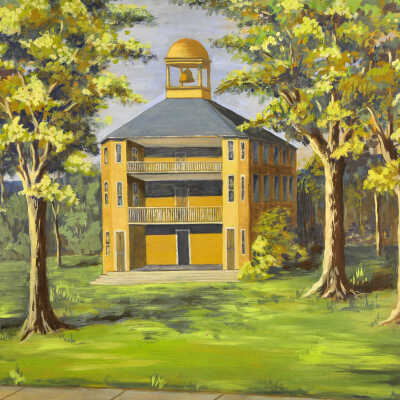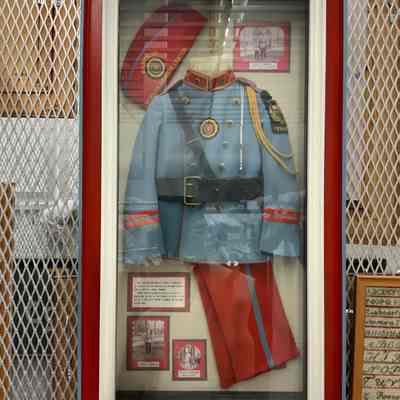113 Painting Rack 6


First State House in Montpelier
Name/Title
First State House in Montpelier
Type of Painting
Description
Acrylic painting depicting a large yellow building, set among tall straight trees. The building has two rounded bays on either side connected with balconies in the center. It is three stories tall and five bays deep. There is a domed cupola at the top with a bell. There are dark mountains visible in the background and a small stretch of sidewalk along the bottom edge. It is signed in the bottom, right, “H. G. Bryan. 1957.”
Acquisition
Accession
1967.169
Source (if not Accessioned)
Bryan, Hortense Maria del Carmen Gomez (1903-1997)
Relationships
Related Places
Place
Montpelier
City
Washington County
County
Vermont
State/Province
United States of America
Country
North America
Artwork Details
Medium
Pastel
Subject
First Vermont State House
Made/Created
Artist Information
Bryan, Hortense Maria del Carmen Gomez (1903-1997)
Artist
Date made
1957
Dimensions
Width
60 in
Height
48 in
Entry/Object ID
1967.169.1
Context
This painting was created as part of a competition and exhibition to reflect a visual understanding of the first Vermont State House. A contemporary written description of the State House was provided to the artists and can be found on a typewritten sheet affixed to the back of the panel.
The first State House was designed by Sylvanus Baldwin and constructed of wood in 1808. The building famously hosted a speech by General Lafayette on his grand U.S. tour in 1825. The building was torn down upon the completion of the Second Vermont State House in 1838 (construction started in 1833). The current Vermont Supreme Court building stands on site of this first State House.
The first State House was designed by Sylvanus Baldwin and constructed of wood in 1808. The building famously hosted a speech by General Lafayette on his grand U.S. tour in 1825. The building was torn down upon the completion of the Second Vermont State House in 1838 (construction started in 1833). The current Vermont Supreme Court building stands on site of this first State House.


Governor Ernest Gibson, Jr.
Name/Title
Governor Ernest Gibson, Jr.
Description
Portrait drawing of a man. The man has wavy hair that is parted in the center and slicked away from his face. He has dark eyebrows, with one raised slightly higher than the other. He is shown wearing a light-colored suit and dark, striped tie. At the bottom right is the large cursive inscription "Gov. Gibson" and the outlines of the initials, "N R".
Acquisition
Accession
1983.32
Artwork Details
Medium
Pastel
Subject Person
Gibson, Ernest Willard, Jr. (1901-1969)
Made/Created
Artist Information
Rockwell, Norman Perceval (1894-1978)
Artist
Date made
1946-1947
Dimensions
N/A
Entry/Object ID
1983.32.1
Type of Drawing
Context
Ernest William Gibson Jr. (March 6, 1901 – November 4, 1969) was a Vermont attorney, politician, and judge. He served briefly as an appointed United States Senator, as the 67th Governor of Vermont, and as a federal judge.
Born in Brattleboro, and the son of a prominent Vermont political figure who served in the United States Senate, Gibson graduated from Norwich University in 1923, attended The George Washington University Law School, and attained admission to the bar in 1926. A Republican, he served in several elected and appointed positions in state government. When his father died while serving in the Senate, Gibson was appointed to temporarily fill the vacancy, and he served from June 1940 to January 1941.
A veteran of the United States Army Reserve and Vermont National Guard, during World War II, Gibson served in the South Pacific and on the staff of the United States Department of War, and received several decorations for heroism. In 1946, he ran for Governor of Vermont and defeated the incumbent in the Republican primary, the only time this has ever occurred in Vermont. He went on to win the general election, and won reelection in 1948.
Gibson served as governor until accepting appointment as judge of Vermont's U.S. District Court; he remained on the bench until his 1969 death in Brattleboro. He was buried at Morningside Cemetery in Brattleboro.
Born in Brattleboro, and the son of a prominent Vermont political figure who served in the United States Senate, Gibson graduated from Norwich University in 1923, attended The George Washington University Law School, and attained admission to the bar in 1926. A Republican, he served in several elected and appointed positions in state government. When his father died while serving in the Senate, Gibson was appointed to temporarily fill the vacancy, and he served from June 1940 to January 1941.
A veteran of the United States Army Reserve and Vermont National Guard, during World War II, Gibson served in the South Pacific and on the staff of the United States Department of War, and received several decorations for heroism. In 1946, he ran for Governor of Vermont and defeated the incumbent in the Republican primary, the only time this has ever occurred in Vermont. He went on to win the general election, and won reelection in 1948.
Gibson served as governor until accepting appointment as judge of Vermont's U.S. District Court; he remained on the bench until his 1969 death in Brattleboro. He was buried at Morningside Cemetery in Brattleboro.


Uniform
Name/Title
Uniform
Dimensions
Width
23-1/2 in
Height
43-1/2 in
Entry/Object ID
T2023.1.7